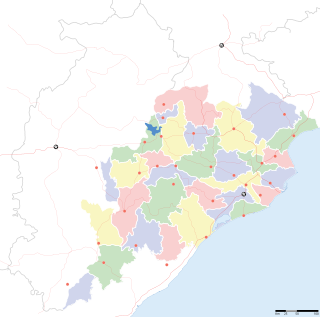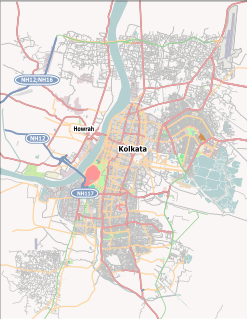Arunachal Congress (AC) was a regional political party in the Indian state of Arunachal Pradesh. It was founded in September 1996 as a splinter group of Indian National Congress, when the local party leader and Chief Minister Gegong Apang revolted against the then Congress leader P.V. Narasimha Rao. Apang took with him 54 members of the legislative assembly of Arunachal Pradesh to his new party. In the Lok Sabha elections 1998 AC won both seats of Arunachal Pradesh. The party received 172 496 votes. AC allied itself with the Bharatiya Janata Party (BJP) and was a founding member of the National Democratic Alliance. The son of Gegong Apang, who had been elected from the constituency Arunachal West, was appointed a minister in the Centre government.
The 2008 Karnataka Legislative Assembly election took place in three phases on 10, 16 and 22 May 2008 in all the 224 assembly constituencies in Karnataka, India. The elections were conducted to elect a Government in the state of Karnataka for the next five years. The votes were counted on 25 May and due to the use of electronic voting machines, all the results were out by the afternoon itself. The Bharatiya Janata Party emerged victorious winning 110 seats. Although the party fell short of a clear majority, it was able to form the government with the support of 6 independents. This was the first time BJP came to power on its own in Karnataka and in any south Indian state.

The Andhra Pradesh Legislative Assembly election of 2009 took place in April 2009, concurrently with the Indian general election, 2009. The elections were held in the state in the first phase (2009-04-16) and second phase (2009-04-23). The results were declared on 2009-05-16. The incumbent Indian National Congress retained power in the Andhra Pradesh State Assembly lower house, though with a reduced majority. The Congress Legislature party re-elected incumbent Chief minister Y.S. Rajasekhara Reddy as its leader thus re-nominating him to the post. Thus, becoming the first politician to serve as Chief Minister of Andhra Pradesh in successive terms.

Elections in Tamil Nadu are conducted every five years to elect the State assembly and its share of members to the Lok Sabha. There are 234 assembly constituencies and 39 Lok Sabha constituencies. The state has conducted 15 assembly elections and 16 Lok Sabha elections since independence.

The 2009 Odisha Legislative Assembly election took place in April 2009, concurrently with the general election. The elections were held in the state in the two phases. The results were declared on 16 May. Despite having recently separated from the Bharatiya Janata Party after an eleven-year partnership, the Biju Janata Dal (BJD) retained power in the Odisha State Assembly with a more convincing majority. Party chief Naveen Patnaik was formally re-elected as the BJD Legislature party leader on 19 May, thus paving the way for his third consecutive term as the Chief Minister of Odisha.

Chowrangee is an assembly constituency in Kolkata in the Indian state of West Bengal. This page includes information about the defunct Fort.

Entally is an assembly constituency in Kolkata in the Indian state of West Bengal.

Sealdah was an assembly constituency in Kolkata in the Indian state of West Bengal.

Vidyasagar was an assembly constituency in Kolkata in the Indian state of West Bengal.

Burtola was an assembly constituency in Kolkata in the Indian state of West Bengal.

Amta is an assembly constituency in Howrah district in the Indian state of West Bengal.

Balagarh is an assembly constituency in Hooghly district in the Indian state of West Bengal. The seat is reserved for scheduled castes.

Pandua is an assembly constituency in Hooghly district in the Indian state of West Bengal.

Dhanekhali is an assembly constituency in Hooghly district in the Indian state of West Bengal. The seat is reserved for scheduled castes.

Tarakeswar is an assembly constituency in Hooghly district in the Indian state of West Bengal.

Arambag is an assembly constituency in Hooghly district in the Indian state of West Bengal. The seat is reserved for scheduled castes. It was an open seat earlier.

Goghat is an assembly constituency in Hooghly district in the Indian state of West Bengal. The seat is reserved for scheduled castes.

Panskura Paschim is an assembly constituency in Purba Medinipur district in the Indian state of West Bengal.
The Andhra Pradesh Legislative Assembly election, 2014 took place on 30 April and 7 May 2014 to elect members to the legislatures of Telangana and Andhra Pradesh. It was held concurrently with the Indian general election. The results were declared on 16 May 2014. The Telugu Desam Party led by N. Chandrababu Naidu won a majority of the 175 seats in the rump Andhra Pradesh, while Telangana Rashtra Samithi led by K. Chandrasekhar Rao won in the new state of Telangana.
Elections in the Republic of India in 2018 included by-elections to the Lok Sabha, elections to the Rajya Sabha, elections to legislative assemblies of eight states and numerous other by-elections to state legislative assemblies, councils and local bodies.






